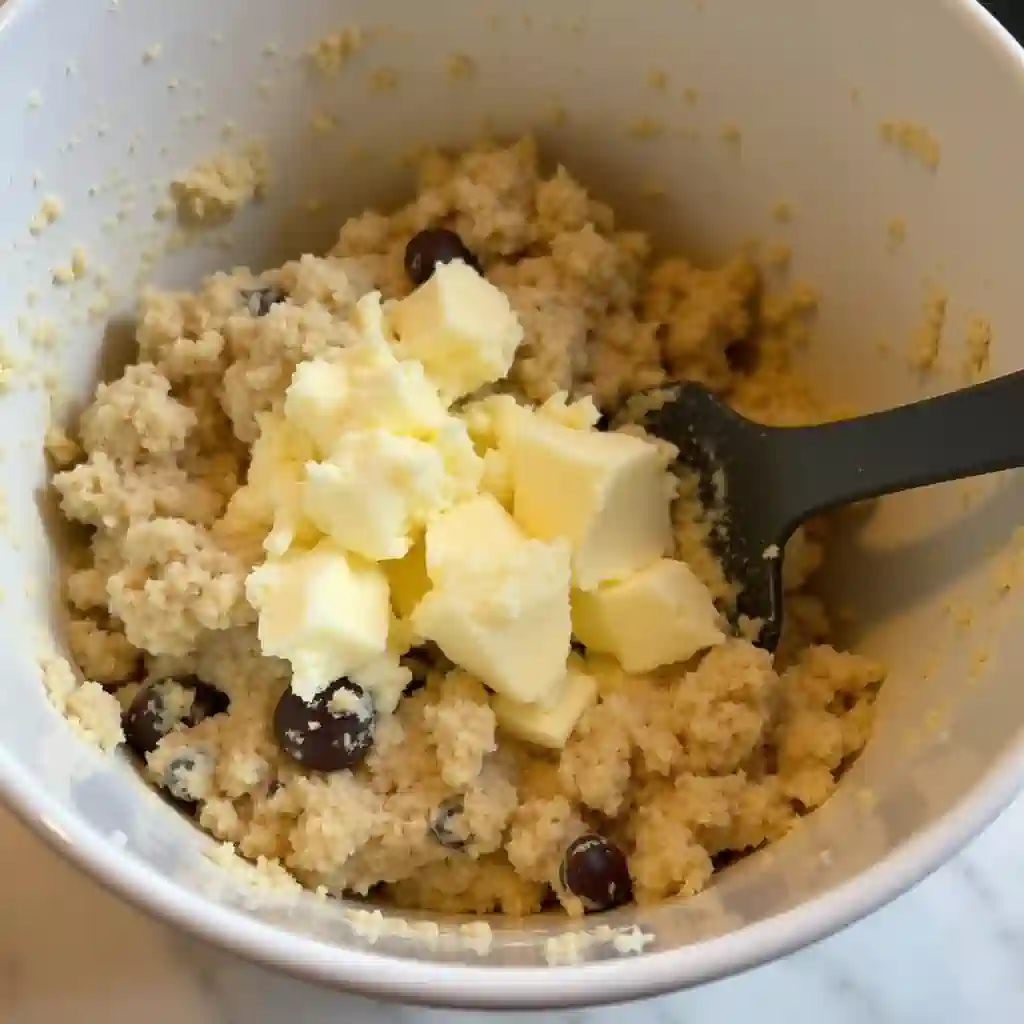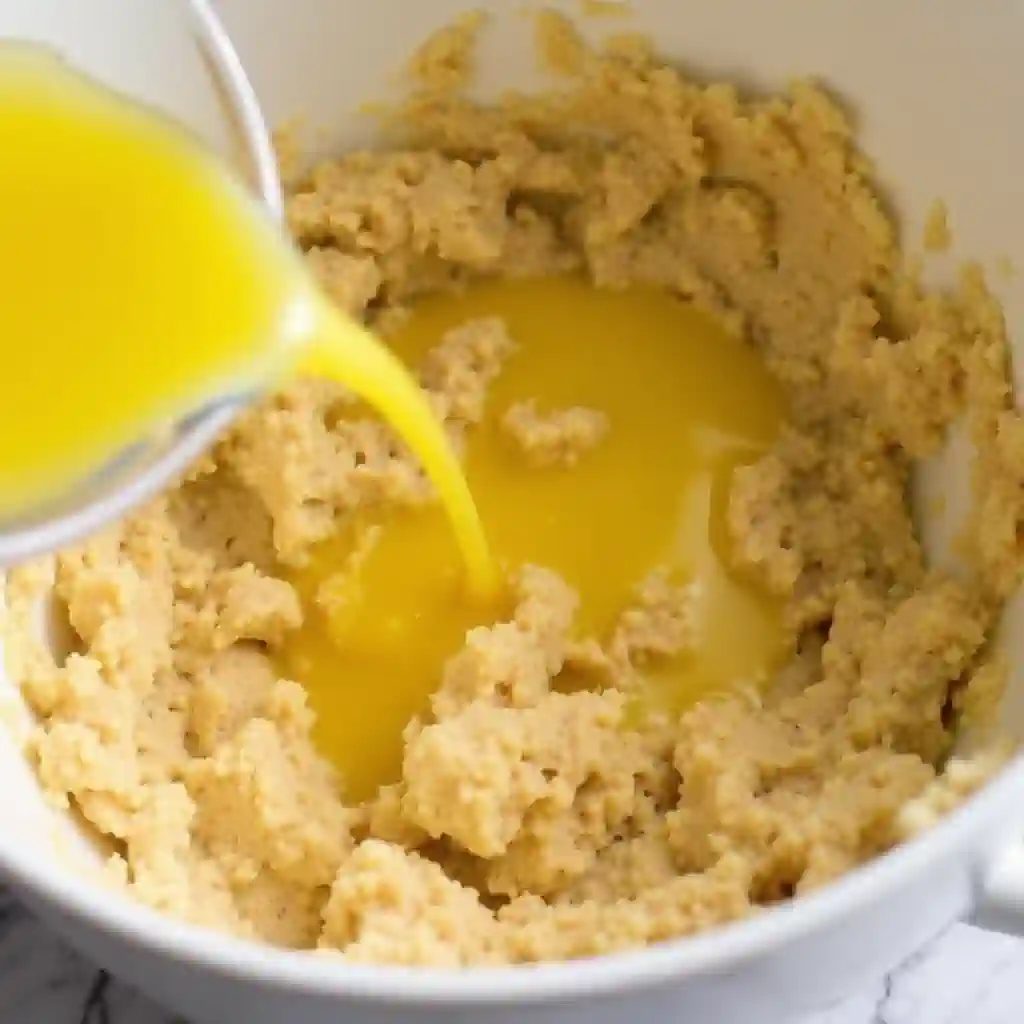When it comes to baking chocolate chip cookies, one of the most common debates is “Is it better to use melted butter or softened butter for chocolate chip cookies?” While both types of butter will get you to the end result—delicious cookies—the texture, consistency, and spread of the cookie can differ drastically based on your choice.
In this article, we’ll dive into the pros and cons of both melted butter and softened butter, how each impacts the texture of your cookies, and when to use them in your baking. Whether you’re craving chewy, thick cookies or thin, crispy ones, understanding the role butter plays in cookie texture is crucial. Let’s explore the science of butter and how it can transform your baking experience.
Table of Contents
Introduction to Butter in Cookie Baking
Why Butter is Crucial in Chocolate Chip Cookies
Butter is essential for chocolate chip cookies. It gives the cookies their flavor and plays a big role in the texture. Whether you want a soft and chewy cookie or a crispy one, butter helps create the perfect balance.
There are two types of butter to consider: softened butter and melted butter. Each affects your cookies differently. Softened butter makes thicker, chewier cookies, while melted butter results in thinner, crispier cookies.
What Happens When You Use Different Butter Consistencies?
Softened butter is soft enough to mix with sugar but still holds shape. This creates a fluffy, chewy texture for your cookies. On the other hand, melted butter is liquid and leads to thinner, crispier cookies.
Softened butter traps air and helps the dough hold shape, while melted butter causes the dough to spread more. So, the type of butter you use will determine if your cookies are thick and chewy or thin and crisp.
Softened Butter vs. Melted Butter

When it comes to making chocolate chip cookies, your choice between melted butter and softened butter can have a profound impact on the final product. While both can produce delicious cookies, the texture and spread can vary drastically depending on which one you choose. Let’s break it down so you can choose the best option for your next batch.
What is Softened Butter and Why Does It Matter for Cookies?
Softened butter is butter that has been left at room temperature for about 30 minutes to an hour. This consistency is perfect for making cookies because it allows the butter to be easily creamed with sugar. Creaming the butter with sugar incorporates air into the dough, which helps make the cookies rise slightly, resulting in a thick, chewy, and soft texture.
Using softened butter in your chocolate chip cookie dough ensures that your cookies will have a puffy, chewy texture. It allows the dough to maintain its shape and helps cookies keep that delightful softness even after they cool down. When you use softened butter, the cookies will be thicker, hold more air, and have a slight chewiness to them that melts in your mouth.
What is Melted Butter and How Does It Affect Texture?
Melted butter, on the other hand, is liquid and has a completely different effect on your cookie dough. When you add melted butter to your dough, the butter mixes in more thoroughly with the sugar and other ingredients, resulting in a more dense, flat dough. This leads to cookies that are thinner and more crispy around the edges.
Because melted butter doesn’t trap air like softened butter does, your cookies will spread more during baking. This creates a flatter cookie that may crisp up more around the edges but still maintains a slightly chewy center, depending on how long they are baked.
In general, melted butter is ideal for those who enjoy crispy chocolate chip cookies with a more delicate, thinner structure. If you’re aiming for thick and soft cookies, softened butter is your best bet.
How Softened Butter Affects the Texture and Spread of Cookies

Now that we’ve looked at the basic differences between melted butter and softened butter, let’s dive deeper into how softened butter specifically impacts the texture and spread of your cookies.
Softened Butter for Chewy and Thick Cookies
When you use softened butter in your chocolate chip cookie dough, the cookies tend to come out thicker and chewier. This is because the butter, when mixed with sugar, creates pockets of air that give the cookies more lift during baking. The dough retains its shape better, preventing the cookies from spreading too much.
The result? A thicker, more substantial cookie with a soft, chewy center. These cookies won’t flatten out like they would with melted butter. Instead, they will have that perfect balance between soft and chewy, holding up well even after they’ve cooled.
If you’re a fan of cookies that stay soft and slightly thick after baking, then softened butter is the way to go. It provides the necessary moisture and structure to keep the cookies from becoming too thin or crispy.
Why Softened Butter Helps Incorporate Air)
The key to chewy chocolate chip cookies lies in the process of creaming the butter with sugar. When you use softened butter, the butter is soft enough to easily mix with the sugar, allowing air to be incorporated into the dough. This aeration creates a lighter, fluffier dough, which ultimately results in cookies that are thicker and softer.
The process of creaming is crucial because it adds volume to the dough. When you beat softened butter with sugar, the mixture becomes light and fluffy, which is what gives the cookies that classic chewy texture. This is an essential technique when baking with softened butter, as it directly impacts the texture and structure of your cookies.
The Impact of Melted Butter on Cookie Texture
Using melted butter in your chocolate chip cookie dough gives you a completely different texture than softened butter. While it’s great for those who love a crispy, thinner cookie, there are a few things you should know about how it affects the overall result. Let’s break it down.
Melted Butter for Thin and Crispy Cookies
When you use melted butter in your cookie dough, the butter mixes more thoroughly into the dough, creating a smoother, denser texture. The cookies spread more as they bake, resulting in a thinner cookie with a more crispy texture around the edges. If you’re someone who enjoys a crunchy cookie, then melted butter might just be your best friend.
This spreading effect happens because melted butter doesn’t trap air like softened butter does. Without those pockets of air, the dough has less structure, so the cookies are more likely to spread out flat. As a result, the cookies become thinner, with crispier edges but still slightly chewy in the center.
Tip: If you love a crispy chocolate chip cookie, melted butter will help you achieve that perfectly crunchy texture. Just make sure to keep a close eye on the baking time to prevent the edges from burning.
How Melted Butter Affects the Cookie Dough
When you melt the butter, it changes the chemical reaction in your cookie dough. The fat in the butter is now in liquid form, which means it combines with the other ingredients more easily. This results in a more homogeneous dough that spreads evenly on the cookie sheet.
However, because melted butter creates a more liquid consistency, the dough doesn’t have the same structure as dough made with softened butter. As a result, cookies made with melted butter may spread too much and could potentially become too thin if you’re not careful. The key here is balancing the amount of butter and using the right mixing techniques to prevent them from being too flat.
The Science Behind Butter and Cookie Texture
So, we’ve discussed how melted butter and softened butter each affect your cookie’s texture, but what’s happening on a deeper level? Let’s take a look at the science behind butter in cookies and how its consistency changes the structure of your dough.
How Fat and Sugar Interact with Softened Butter
When you use softened butter, one of the most important reactions happens when it’s creamed with sugar. Creaming butter with sugar incorporates tiny air bubbles into the dough. These air pockets give your dough a light and fluffy texture. The fat in softened butter coats the flour particles, which limits the amount of gluten that forms during mixing. This creates a softer, chewier cookie.
By using softened butter, you’re also able to more evenly distribute the sugar throughout the dough, which helps maintain a moist cookie after baking. This interaction between fat and sugar is what gives chewy chocolate chip cookies their delicious texture. Without this, cookies would end up being dense and dry, not at all what you want for the perfect bite.
Why Melted Butter Changes the Structure of the Dough
On the other hand, when you use melted butter, the consistency of your dough changes significantly. Melted butter, being in liquid form, combines with the sugar and flour differently than softened butter does. Because it’s already in a liquid state, it doesn’t trap air into the dough, which is why cookies made with melted butter tend to be flat and crisp.
Moreover, melted butter doesn’t coat the flour particles in the same way softened butter does. As a result, the dough may not be as stable or hold its shape during baking, leading to cookies that spread more. This is why melted butter creates those deliciously thin, crispy cookies that some people prefer, especially if they enjoy the crunchy edges.
Baking Techniques with Melted vs. Softened Butter
Now that we’ve covered how melted butter and softened butter affect the texture of your cookies, let’s dive into some practical baking techniques. Understanding when to use each type of butter can help you bake your cookies exactly the way you want them—whether you prefer chewy, thick cookies or thin, crispy ones.
When to Use Melted Butter vs. Softened Butter in Cookie Recipes
As you might have guessed, melted butter and softened butter should be used at different times depending on the desired outcome. If your goal is to bake thick and chewy chocolate chip cookies, then softened butter is your best option. The air incorporated through creaming will help your dough rise, giving your cookies that puffy, soft consistency that everyone loves.
On the other hand, if you’re after thin, crispy cookies, then melted butter is the way to go. Melted butter will allow the dough to spread more easily, creating cookies that are flatter and crispier. This method is often preferred when you’re making thin chocolate chip cookies that have a nice crunchy edge but still a bit of softness in the center.
How to Achieve the Right Consistency and Texture
Achieving the right consistency when using melted butter or softened butter is key. If you’re using softened butter and the dough feels too soft, chill it in the fridge for 30 minutes. This will firm it up and prevent excessive spreading when baking. For melted butter, if the dough seems too runny, you can add a little extra flour to thicken it up and help control how much the cookies spread during baking.
Another tip: if you’re aiming for chewy cookies, ensure that your dough isn’t too dry. A common mistake is adding too much flour, which can lead to dense, hard cookies. For a perfect texture, start with the proper flour measurements and adjust if needed, depending on whether you’re using melted or softened butter.
Frequently Asked Questions (FAQs)
Baking chocolate chip cookies can leave you with a lot of questions. Let’s answer some of the most common ones to help you bake the perfect cookies every time.
Are Chocolate Chip Cookies Better with Melted or Softened Butter?
When you ask, “Is it better to use melted butter or softened butter for chocolate chip cookies?” the answer depends on your preference. If you love thick, chewy cookies, then softened butter is your best option. However, if you prefer cookies that are thinner and crisper, go for melted butter. Both can work well; it just depends on the texture you’re aiming for.
Do You Use Melted or Softened Butter for Cookies?
The choice between melted or softened butter boils down to the type of cookie you want. Softened butter is ideal for a chewy, thick texture, while melted butter creates thin and crispy cookies. It’s all about your personal taste!
What Happens if You Use Melted Butter Instead of Softened Butter in Baking?
If you use melted butter instead of softened butter in your chocolate chip cookies, you’ll get a flatter, crisper cookie. Melted butter causes the dough to spread more as it bakes. This is perfect if you’re looking for cookies with a thin, crunchy texture. On the other hand, softened butter will keep the dough thicker and result in a more chewy cookie.
Does It Matter What Butter You Use for Cookies?
Yes, the type of butter you use has a significant impact on your cookies’ texture. Melted butter creates a different cookie than softened butter. So, if you want cookies that are soft and chewy, make sure to use softened butter. If you prefer them crispy, melted butter is the way to go.
Key Takeaways for Choosing the Right Butter
After exploring the differences between melted butter and softened butter, it’s clear that your choice plays a crucial role in how your chocolate chip cookies turn out. Let’s summarize the most important points to keep in mind when deciding between these two options.
Softened Butter for Chewy, Thick Cookies
If you’re aiming for a thick, chewy cookie, softened butter is your best bet. When you use softened butter, you’re able to cream it with sugar, which helps to incorporate air into the dough. This results in cookies that have a soft, fluffy texture that maintains their thickness after baking. Softened butter will give you that classic, chewy chocolate chip cookie that we all know and love.
Melted Butter for Thin, Crispy Cookies
On the other hand, if you prefer a thin and crispy cookie, melted butter is the way to go. The liquid form of melted butter causes the dough to spread more as it bakes, resulting in cookies that are flatter and crisper. So, when you ask, “Is it better to use melted butter or softened butter for chocolate chip cookies?”, the answer depends on whether you prefer chewy or crispy cookies.
In conclusion, knowing whether you want your cookies to be soft or crispy should guide your decision on which butter to use. Both types have their place in cookie baking, and both will create delicious results depending on your personal taste.
Final Thoughts and Baking Tips for Perfect Cookies
At the end of the day, butter consistency matters when it comes to making the perfect chocolate chip cookies. Whether you use softened butter or melted butter will ultimately affect your cookie texture and overall outcome. Let’s wrap up by reviewing some final thoughts and helpful tips for ensuring your cookies turn out exactly as you like.
Baking Tips for Perfect Cookies
- Measure Butter Carefully: No matter which type of butter you choose, make sure to measure it correctly. Too much butter can cause cookies to spread too much, while too little can result in a dry texture.
- Chill the Dough: If you’re using softened butter and want to prevent cookies from spreading too much, chill the dough for at least 30 minutes. This will help the cookies hold their shape and stay thicker during baking.
- Adjust Baking Time: Depending on your butter choice, you may need to adjust your baking time. Cookies made with softened butter may need a slightly longer time to bake, whereas cookies made with melted butter might bake a bit faster. Keep a close eye on them!
The Secret to the Perfect Cookie Texture
The secret to getting the perfect chocolate chip cookies lies in your butter choice, but it also depends on how you handle your dough. Whether you use melted butter for crispy edges or softened butter for a chewy center, the balance of ingredients and techniques will make all the difference.
Remember, if you want to experiment, try making one batch with softened butter and another with melted butter to see which texture you like best. The beauty of cookie baking is that it’s all about personal preference, so don’t be afraid to adjust based on your tastes.
Happy baking, and enjoy your delicious, perfectly-textured cookies!
Related Articles
- Toll House Chocolate Chip Cookie Recipe: How To Nail The Original Flavor
- What Is The Secret Ingredient To Keep Cookies Soft? The Ultimate Baking Hack
- Apple Chocolate Chip Cookies Recipe: A New Favorite For Your Cookie Jar
- What Is The Basic Meatloaf Formula? Simple Ingredients, Perfect Results
- Is it Better to Bake Bone-In Chicken at 350 or 400?
- Smoked Meatloaf Recipe: How To Make The Best Smoked Meatloaf Ever
- Vegan Venison Chili: Delicious and Nutritious Plant-Based Recipes

